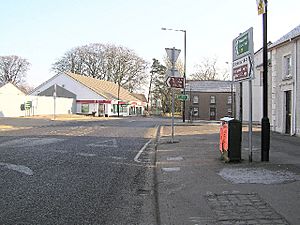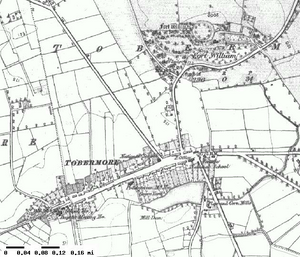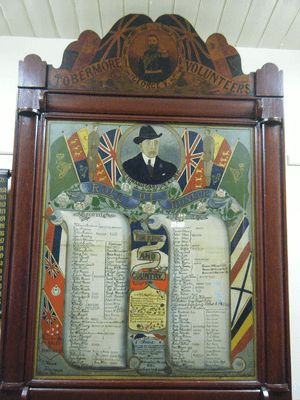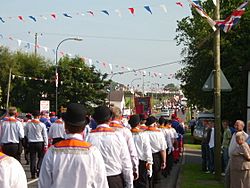Tobermore facts for kids
Quick facts for kids Tobermore
|
|
|---|---|
 The village centre |
|
| Population | 578 (2001 Census) |
| Irish grid reference | H8396 |
| • Belfast | 34 mi (55 km) |
| District |
|
| County | |
| Country | Northern Ireland |
| Sovereign state | United Kingdom |
| Post town | MAGHERAFELT |
| Postcode district | BT45 |
| Dialling code | 028 |
| Police | Northern Ireland |
| Fire | Northern Ireland |
| Ambulance | Northern Ireland |
| EU Parliament | Northern Ireland |
| UK Parliament |
|
| NI Assembly |
|
Tobermore (locally [ˌtʌbərˈmoːr]) is a small village in County Londonderry, Northern Ireland. Its name comes from the Irish words An Tobar Mór, meaning "the great well".
The village is about 2.5 miles (4 km) south-south-west of Maghera. It is also about 5.5 miles (9 km) north-west of Magherafelt. Tobermore is part of the Mid-Ulster District.
Tobermore has won awards for being a well-kept village. It won the Best Kept Small Village award four times. In 1986, it won the Best Kept Large Village award. In September 2011, Tobermore won the Translink Ulster in Bloom village award for the third year in a row.
Contents
- Understanding Tobermore's Name
- Exploring Tobermore's Landscape
- A Look at Tobermore's Past
- Tobermore's Local Culture
- Masonic Order in Tobermore
- Tobermore's Population
- Famous People from Tobermore
- Education in Tobermore
- Sports in Tobermore
- See also
Understanding Tobermore's Name
Tobermore gets its name from the local area, also called Tobermore. The name is an English version of the Irish words tobar and mór. Tobar means "well," and mór means "big" or "great." So, Tobermore means "big well" or "great well."
In the 1600s, the village was also known as Tobarmore and Tubbermore. Even today, the Masonic Order often uses the name Tubbermore.
Exploring Tobermore's Landscape
Tobermore is located on the side of Slieve Gallion, a large hill. Some other notable hills nearby include Calmore Hill, which is 268 feet (82 meters) high. Fortwilliam Hill, located in Tobermore, is 200 feet (61 meters) high.
A very large oak tree once grew near Calmore Castle in Tobermore. It was called the Royal Oak. People said it was so big that horse riders could not touch each other across it with their whips. This suggests the tree was about 10 feet (3 meters) wide. Another tall, straight oak tree was known as the Fishing Rod. It is believed that all the local areas were once covered with magnificent oak trees.
The Moyola River flows from west to east about half a mile north of Tobermore village. It passes through the areas of Ballynahone Beg and Ballynahone More. In these two areas, you can find Ballynahone Bog. This is one of the largest lowland raised bogs in Northern Ireland.
A Look at Tobermore's Past
How Tobermore Started
The first mention of a settlement in Tobermore dates back to the mid-1700s. A house built in 1727 belonged to a person named James Moore. At some point in the 1700s, a local fair was moved to Tobermore. At that time, the village only had Moore's house and a few small mud huts. The village began to grow and develop from this period onwards.
Early History of the Area
Fortwilliam Hill and Rath
Fortwilliam Hill is located between Fortwilliam, Lisnamuck, and Maghera roads in Tobermore. It overlooks the Moyola River. On this hill, you can find Fortwilliam rath, which is an ancient circular fort built around 700–1000 AD. Fortwilliam House, a historic building, was built in 1795.
The rath was once known as Donnagrenan. This name likely comes from the Irish words Dún na Grianán, meaning "fort of the eminent place." Its modern name, like the house, was given by Mr. Jackson. He named it after Fort William, Scotland, which was named in honor of King William III in 1690.
Fortwilliam rath is a well-preserved monument. It was built to protect against attacks. It is quite large, about 30 meters (98 feet) across. It is considered a monument of regional importance and is protected by law. Fortwilliam House was described in 1821 as a beautiful building with a great view.
Kilcronaghan Parish Church
Presbyterian Church in Tobermore
The first Presbyterian church that served Tobermore and the wider area was started in Knockloughrim in 1696.
In 1736, people asked the Presbyterian Synod of Ulster to create a church in Tobermore. This first request was turned down. This was because it would have made the church in nearby Maghera too small. In 1737, they asked again and made a very strong case. The Synod then agreed to the new church.
The boundary between the Maghera and Tobermore churches was set as the Moyola River. However, in 1743, nineteen families from Ballynahone, which is on both sides of the river, were moved from the Maghera church to the Tobermore church. The fourth minister of the Tobermore church, Reverend William Brown, saw a need for a new church in Draperstown. He helped set it up in 1835. This meant losing about 70 families from his Tobermore church.
Volunteers and Yeomanry Groups
In November 1780, a meeting was held for the Tobermore Volunteer company. This group was led by John Stevenson. The Reverend James Whiteside gave a speech at this meeting.
During the 1800s, the British government created reports listing the Yeomanry officers in Ireland. These groups were like local militias. For Tobermore, the following officers were listed:
- In 1804: Captain James Stephenson, Lieutenant Robert Bryan, and Samuel M'Gown (McGowan).
- In 1825: Captain James Stevenson.
- In 1834: Captain James Stevenson, Lieutenant John Stevenson, and Lieutenant H. Stevenson.
Local Disputes Over Rent
In the early 1800s, people living in Tobermore sometimes had disagreements about paying rent to their landlord, Mr. Miller of Moneymore. It was said that the residents sometimes resisted when their cattle were seized for unpaid rent. They used tools like pitchforks to resist. When they saw that resistance was not working, they hired a lawyer, Mr. Costello. He tried to argue their case in court, but they were not successful there either.
A legal case between Ball and Co. of Dublin and Sir George Hill caused problems for the village's growth. The main reason people did not pay rent was that they did not feel safe. They worried they might have to pay the same year's rent again.
During this time, there were no major crimes like illegal alcohol making. There were also no big disturbances for many years. The only exceptions were a few fights in the street when people came to collect rent. After rent payments started again, it was noted that even though they had not paid rent for a long time, no one became richer. This might have been because their rent money often went to local shops instead of being saved.
Orange and Temperance Hall
The Tobermore Orange and Temperance Hall was built in 1888. It was built by Andrew Johnston of Aghagaskin, Magherafelt. This hall is used for band practices. It is also used by several groups. These include Orange Order lodges 131 and 684, and Royal Black Preceptory lodge 390. The Tobermore Walker Club of the Apprentice Boys of Derry and Tobermore Masonic Lodge also use the hall.
Modern History
Home Rule Movement
At the end of the 1800s and start of the 1900s, a big issue in Ireland was Irish Home Rule. This meant Ireland would have its own government. In 1893, Viscount Templeton started the first Unionist Clubs. These clubs worked to oppose Home Rule. Hiram Parkes Wilkinson founded the Tobermore Unionist Club.
In 1912, Rev. J. Walker Brown wrote a pamphlet against Home Rule. It was called The Siege of Tobermore. In it, he described how to defend Tobermore if "the enemy" marched on the village. This was similar to the Siege of Derry.
Tobermore is also mentioned in a song against Home Rule called The Union Cruiser.
World War I Efforts
During World War I, 121 people from Tobermore joined the Ulster Division. This was out of a population of about 350. The Mid Ulster Mail newspaper reported that Tobermore had a special war record. Of those who joined, 24 were killed and 33 were wounded.
The names of these volunteers are on a special Roll of Honour. It was painted by a local man, Samuel Nelson. Denis Henry, a Member of Parliament, unveiled it. This Roll of Honour is kept in the Tobermore Orange & Temperance Hall.
In Tobermore's Presbyterian graveyard, there is a headstone for Bobbie Wisner. He died of natural causes at home in 1915. He had trained with his adult comrades in the 36th Ulster Division. Because he was so respected, he was buried with full military honors.
Anglo-Irish War Period
During the period of the Belfast Troubles (1920–1922), there were some incidents in Tobermore. On April 2, 1921, there was an attempt to blow up the bridge over the Moyola River near Tobermore. On March 19, 1922, the bridge was damaged again by explosives. Four days later, a flax mill was burned down.
Because of these events, the Orange Hall on Main Street became a temporary base. It was used by members of the Ulster Special Constabulary (USC). Sandbag positions were set up in the village center. Seventeen men were called up to form the local group.
On May 26 of that year, the temporary base was briefly attacked by the Irish Republican Army. No one was hurt after the police fired back, and the IRA members left. Later, steel shutters were added to the windows for safety. The special police group stayed for six months before being stood down.
Victory Day Celebrations
In 1946, Tobermore held a special event to celebrate the end of World War II. The Constitution newspaper said it was the first event of its kind in South Derry. It was also one of the first "Victory Day" celebrations in the region. The newspaper also noted that Tobermore's "Victory Salute" was a way to show the pride people in South Derry felt about the Allied victory.
Many efforts were made to make sure the event was a big success. The newspaper said that Tobermore's Victory Fete would be remembered as one of the most important events in the area.
Sir Ronald Ross, a Member of Parliament, attended the Victory Fete. The band of the 1st Battalion Royal Ulster Rifles also performed. Local groups of the Maghera and Tobermore Army Cadet Force were also present.
The Troubles Period
During the modern Troubles, Tobermore was in an area that experienced conflict. Some people who were killed in the Tobermore area were Protestant:
- Samuel Porter (30), was killed on November 22, 1972. He was a member of the Ulster Defence Regiment. He was shot outside his home in Ballynahone while off-duty.
- Noel Davis (22), was killed on May 24, 1975. He was a member of the Royal Ulster Constabulary. He was killed by a bomb in an abandoned car in Ballynahone, near Tobermore.
- Alexander Watters (62), was killed on March 16, 1977. He was a civilian. He was shot while cycling on the road between Tobermore and Draperstown.
On September 7, 1968, groups of the Ulster Protestant Volunteers marched through Tobermore. There were eight bands and about 450 people. Most of them wore sashes from the Ulster Constitution Defence Committee. Ian Paisley and ministers from the Free Presbyterian Church of Ulster were very visible in the parade.
In October 1972, an Ulster Vanguard political meeting was held in Tobermore. John Taylor, the deputy leader of the Ulster Unionist Party, gave a speech.
There were four bomb hoaxes in Tobermore during 2010. The most recent were on July 29, 2010, and August 19, 2010. Both were found in the village center. They caused traffic problems and forced people to leave their homes for a short time.
Tobermore in the 21st Century
On August 16, 2008, over twelve hours of heavy rain caused the Moyola River to overflow. This led to flooding on the main Tobermore-Maghera road. The nearby buildings and pitch of Tobermore United F.C. and Tobermore Golf Driving Range were also flooded.
Tobermore's Local Culture
Every seven years, the main 12 July Orange Order parade for the region is held in Tobermore. The most recent one was in 2022. In 2005, the Twelfth in Tobermore included a group from Birmingham, Alabama, USA. Like many other places in Northern Ireland, Tobermore celebrates the Eleventh Night. This is the night before the 12 July Orange Order celebrations. Traditional activities on Eleventh Night include playing Lambeg drums. There is also a parade through the town by the local band. A large bonfire is lit as well.
Local Bands
Tobermore has two flute bands: Tobermore Loyal F.B. and Blackhill F.B. Both bands take part in the Unionist Marching season. Earlier bands included Tobermore Flute Band, started after 1855. It stopped playing in 1914 because of World War I. It reformed in 1918 and played until 1934. In 1934, the Duke of York Accordion Band was formed. In 1981, an old ticket for a "Grand Ball" from 1896, linked to Tobermore Flute Band, was found.
Millrow Flute Band was another Tobermore band. It started in the early 1970s and stopped in 2000. In the 1970s, a style of music became popular with loyalist bands. Millrow used this style and became one of the biggest and most famous loyalist bands of the 1970s and 80s. In 1977, Millrow F.B. released a music album. They also appeared on a CD called Ulster's Greatest Bands Meet.
Parades and Processions
According to the Parades Commission, there were nine parades in Tobermore in 2011. There were twelve in 2012, which included the regional Twelfth celebrations. In 2013, there were eight parades. These parades include groups like the local flute band Tobermore Loyal. Other groups are the Tobermore branch of the Walker Club of the Apprentice Boys of Derry. The Royal British Legion, the Royal Black Institution, the Boys' Brigade, and the local Orange Order lodge also hold parades.
Masonic Order in Tobermore
Tobermore has its own Masonic Order lodge. Its name is Eureka, and its lodge number is 309. When it was founded, Tobermore was often called Tubbermore. Lodge 309 is still referred to by the Masonic Order as being in Tubbermore.
In 1747, a permit was given to create a Dublin Masonic Lodge, number 169. This permit was cancelled in 1765. However, by 1811, lodge 169 appeared again in Magherafelt. In 1825, lodge 169 moved from Magherafelt to Tobermore. By 1838, it had moved to Moneymore. Since 1895, lodge 169 has been located in Belfast.
Tobermore's Population
As of the 2011 census, Tobermore had a population of 827 people. About 5.1% of the people were from a Catholic background. About 90.5% were from a Protestant background.
Famous People from Tobermore
- Dr. Adam Clarke (1762–1832) – A British Methodist religious scholar. He was born in the area of Moybeg, north of Tobermore village.
- Alexander Carson (1776–1844) – An Irish Baptist pastor and writer. His church in Tobermore, founded in 1814, was named the Carson Memorial in his honor. A housing area across from it is called Carson Court.
- Harry Gregg MBE (1932–2020) – A famous former goalkeeper for Manchester United and the Northern Ireland team. Gregg was born in Tobermore but grew up in Coleraine.
- Hiram Parkes Wilkinson, BCL, KC (1866–1935) – The son of Sir Hiram Shaw Wilkinson (see below). He worked as a lawyer in Shanghai and as a judge. He founded the Tobermore Unionist Club.
- Sir Hiram Shaw Wilkinson, JP, DL (1840–1926) – A British judge and diplomat. He worked in Shanghai and Japan. After he retired, he moved to the area of Moneyshanere, near Tobermore.
Education in Tobermore
Before public primary schools, churches mainly provided education. In Tobermore, the Church of Ireland parish of Kilcronaghan has records of its school masters from as far back as 1686. The Parish School was first built in the area of Granny. This was on the main road between Tobermore and Draperstown. Even though it was a Church of Ireland school, children of all religions could attend. In 1836, 70 children were enrolled. Twenty-eight were Church of Ireland, 20 Presbyterian, 2 Roman Catholic, and 20 from other groups. Subjects like arithmetic and English were taught.
The local Presbyterian Church also started its own school. It was held in the Session House behind the Presbyterian church. Private evening classes for adults were also held there twice a week.
Tobermore's first public school opened in 1817. It was in a room that used to be a public house. This school is now Tobermore Primary School. In 1826, Killytoney National School was established. It was built on the old road between Tobermore and Desertmartin. It has been part of the National Board since 1833. During this time, there were seven other schools in Kilcronaghan Parish. Four were for girls, one of which taught in Irish. There was also an Irish boys' school and two national schools. By 1967, Kilcronaghan Parish School closed. It joined with Black Hill School and Sixtowns School to become Kilross Primary School.
There are two schools in the Tobermore area today. Both are part of the North Eastern Education and Library Board. These are Tobermore Primary School and Kilross Primary School.
For secondary education, students from Tobermore usually go to schools in Magherafelt. Some also go to Draperstown. The Tobermore area has very good education results. In 2008, 88.8% of students achieved 5 or more GCSEs at grades C+ or higher. This is higher than the average for Magherafelt District Council (71.8%). It is also higher than the average for Northern Ireland (66.9%).
Sports in Tobermore
Tobermore United F.C. is the local association football (soccer) club. As of 2022, the club played in the NIFL Premier Intermediate League. Tobermore United is famous because George Best, a legendary football player, played for them. He played a competitive match for the club in February 1984. This was the only time he played competitively for a club in Northern Ireland.
The village also has a dart team, the Diamond Bar Dart Team. In the 2004/05 season, they won the South Derry Darts 2nd Division League. They also won the South Derry 2nd Division League Cup.
The Tobermore Golf Driving Range opened in 1995. It has two levels and 34 hitting bays.
|
See also
 In Spanish: Tobermore para niños
In Spanish: Tobermore para niños






